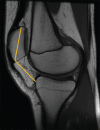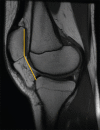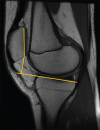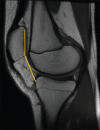Evaluation of patella alta using MRI measurements in adolescents
- PMID: 28744079
- PMCID: PMC5510316
- DOI: 10.4103/ijri.IJRI_222_16
Evaluation of patella alta using MRI measurements in adolescents
Abstract
Purpose: To determine whether or not there were any differences in the measurement techniques used by orthopedic and radiology specialists in the evaluation of magnetic resonance (MR) images for the diagnosis of patella alta in adolescents.
Materials and methods: Evaluations were performed by three orthopedic specialists (Group I) and three radiology specialists (Group II) regarding the presence of patella alta in 40 adolescents cases using the Insall-Salvati, Caton-Deschamps, Blackburne-Peel, and modified Insall-Salvati indices on MR images obtained to diagnose patellar instability.
Results: The Fleiss Kappa conformity levels for Insall-Salvati, Caton-Deschamps, Blackburne-Peel, and modified Insall-Salvati measurements were 0.531, 0.559, 0.246, and 0.272, respectively, in Group I, and 0.699, 0.346, 0.516, and 0.394, respectively, in Group II.
Conclusion: The radiology specialists were found to have greater conformity in the evaluation of all patella alta indices, which was probably due to their greater familiarity with radiological measurements than that of the orthopedic specialists.
Keywords: Blackburne–Peel; Caton–Deschamps; Insall–Salvati; modified Insall–Salvati; patella alta.
Conflict of interest statement
There are no conflict of interest.
Figures





References
-
- Dejour H, Walch G, Nove-Josserand L, Guier C. Factors of patellar instability: An anatomic radiographic study. Knee Surg Sports Traumatol Arthrosc. 1994;2:19–26. - PubMed
-
- Insall J, Salvati E. Patella position in the normal knee joint. Radiology. 1971;101:101–4. - PubMed
-
- Blackburne JS, Peel TE. A new method of measuring patellar height. J Bone Joint Surg [Br] 1977;59:241–2. - PubMed
-
- Caton J, Deschamps G, Chambat P, Lerat JL, Dejour H. Patella infera. Apropos of 128 cases. Rev Chir Orthop Reparatrice Appar Mot. 1982;68:317–25. - PubMed
-
- Narkbunnam R, Chareancholvanich K. Effect of patient position on measurement of patellar height ratio. Arch Orthop Trauma Surg. 2015;135:1151–6. - PubMed
LinkOut - more resources
Full Text Sources
Other Literature Sources

